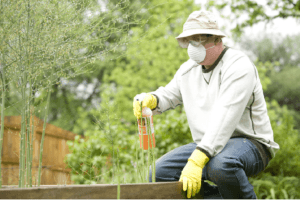Contents
PESTICIDE INDUSTRY
Pesticide is a chemical used to destroy an organism detrimental to human interest. It includes insecticide detrimental to human interest. It includes insecticides, fungicides, herbicides, rodenticides, bactericides, miticides, nematocides, molluscicides. They are generally halogenated (Cyclodienes, Bischlorophenyls, Cycloparaffins, Organo-chlorines and Chlorinated terpenes) or Organo-phosphorus (Parathion, malathion, TEPP, OMPA, DDVP, abate, ciodrin etc.) type. They are classified as extremely hazardous, highly hazardous, moderately hazardous, slightly hazardous etc. For these classifications and their details including Lethal Dose values see Reference No. 1 given at the end of this Chapter. Strict safety rules are necessary during their processing, handling, packaging etc. Exhaust ventilation and use of PPE are essential.
Statutory Provisions for pesticide safety:
Schedule 15, Rule 102, GFR, Sch 15, Rule 114, MFR and Sch.29, Rule 95, TNFR give statutory provisions for manufacture and handling of dangerous pesticides listed in Appendix first to that Schedule. Appendix-second gives cautionary placed.
The measures include prohibition of employment of women and young persons, air space of 500 m3 or more per person, efficient exhaust draft on charging, discharging, blending and powder or liquid preparation, sound and sloping floor with gutters and drainage, daily washing, workbenches of stainless steel, waste container with lid and waste disposal by burning, safe disposal of empty containers, no manual of direct handling, protective clothing and their daily washing, medical facilities including doctor and antidotes and medical examination pre employment quarterly examination and record in Form 20, GFR additional rest interval of 10 minutes before each meal and before the end of the day’s work, washing and bathing facilities with at least 50% bathrooms and 1 place for 5 workers with clean towels, soap and nail brushes, prohibition of food and drink in workrooms, cloak room for clothing and PPE, mess room with in-charge person and prior permission of the CIF to start manipulation of a new pesticide.
LIST OF DENGEROUS PESTICIDES
| Parthion | Mercury compounds |
| Diazinon | Methyl bromide |
| Hexaethyl tetra phosphate | Cyanides |
| Tetraethyl di trlopyrophosphate | Endrin |
| Demeton (systex) | Aldrin |
| SChradam (OMPR) | Dieldrin |
| Para-Oxon (E.600) | Texaphene |
| Methyl Parathion | Dinitro-o cresol |
| Dimefox | Arsenical compounds |
| Tetraethyl pyrophosphate | Chlordane |
| Sulphotepp | Cryolite |
| EPN | Pentachlorophenol |
| Nicotine or its compounds | Carbojuran |
This list gives commonly used pesticides. It is better to refer the exhaustive list u/s 3(e) of the Insecticides Act.

- Good quality rubber hand gloves, waterproof suit or apron, gumboot and air-line respirator. Safety showers and bathrooms shall be provided.
- Illiterate, untrained and temporary contract workers are exposed to more risk. Therefore such training should be given to them so that they can read or understand the necessary precautions.
- Pedestal or positive air fan remove the vapour or dust from one workers to another. Therefore it is inadvisable. Exhaust or negative air suction and air-line respirators are the effective remedies. Exhaled air should be passed through carbon bed filter or effective absorber and final vent discharge should be within safe limit.
- Regular air monitoring at work place, ppm record and leakage checking are necessary.
- A record of full name, address, signature, date of joining and photograph of all the workers at the time of first employment are useful to detect cases of delayed effect or after-service effect.
- If pre-employment and subsequent medical examination shows blood cholinesterase level less than 62.5%, that worker should not be employed in pesticide work. If RCB level is also low, the worker should be kept away for 3 months from such process. Sufficient stock of PAN, Atropine etc. (antidotes) should be kept in the factory first-aid centre.
- The workers must be aware that in case of symptoms (dizziness, headache, vibration, vomit etc.), which doctor they have to approach. They will follow the medical advice.
- In each shift, qualified and trained supervisor shall strictly supervise the working conditions, work habits, methods, use of PPE, washing, cleaning and no smoking, eating or drinking in work area.
Specified medical treatment is as under:
- In case of skin contact of organo-phosphorous, it is should be immediately treated with solution of 5-10% ammonia or 2-5 % chloramines.
- Give injection Atropine sulphate according to age, 2 to 4 mg intravenous or intramuscular Continue this injection every 5 to 10 minutes till pupils size and heart beats become normal.
- Give injection PAM (2-Pyridine Aloxime Methochloride ) in glucose slowly. Toxogonin is a condensation product of Pyridine aldoxime and dichlorodimethyl ether.
- Maintain fluid and electrolyte balance.
- Give antibiotic medicine to prevent secondary infection.
- Give Frusemide if lungs are swallowed or water filled.
- If breathing stops, artificial respiration must be tried till doctor comes. The patient should be kept in a cool and quiet place. Give oxygen if difficulty is in breathing. If breathing trouble is more, the victim should be shifted to hospital and put on ventilator.
- Personal hygiene – to wash hands and mouth before and after lunch and bathing and changing clothes at the end of the work – is highly assential.






Great initiative. Publish more safety related informations for saving the workmen from safety hazards
Thanks a lot.
I appreciate your efforts.Wish you all the best in your life.
Thank You!!!!